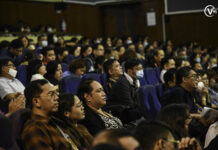THE MIGUEL de Benavides Library saw a decrease of 69 percent in the number of books borrowed by users in the past five years, data obtained by the Varsitarian showed.
The Central Library recorded a total of 39,516 books borrowed last semester, the lowest number of books checked out since Academic Year (AY) 2013 to 2014, which saw a total of 126,319 borrowed books. A total of 130,981 books were borrowed in AY 2014 to 2015; 129,766 in AY 2015 to 2016, 107,570 in AY 2016 to 2017; and 84,520 in AY 2017 to 2018.
Chief Librarian Ma. Cecilia Lobo attributed the decline in book borrowing to the increasing number of Thomasians opting for electronic resources. She said it was possible that more students preferred using the resources only while inside the library, as using electronic resources outside was more convenient.
“[K]ahit madaling araw puwedeng i-access ‘yong mga digital resources samantalang kapag book, you have to come here to borrow it,” Lobo told the Varsitarian in an interview.
The decline in book borrowing, however, does not mean Thomasians no longer utilize the library resources, she said.“Puwedeng ayaw lang [ng Thomasians] i-uwi [‘yong mga libro] kasi mabigat, samantalang ‘yong mga smartphone, isang picture lang dalawang picture ‘di ba?’” she said.
Despite the decline in book borrowing, library visitors increased by 89 percent to 949,329, from 501,600 visitors in 2013.
Diana Padilla, assistant chief librarian, said students should maximize the use of library resources whether online or in the library.
Lobo and Padilla maintained that the reasons they mentioned behind the book borrowing decline were just “assessments,” as they did not conduct any study on the matter.
Use of electronic, online resources on the rise
While the number of borrowed books has decreased, the library’s online and electronic presence has expanded, a report for AY 2017 to 2018 bared. The report showed 10,948,882 remote log-ins in the library’s electronic database, which included the accessing of electronic journals, e-books, open-access resources and local databases, among others.
Lobo said the demand for digital materials was a result of greater research activity among undergraduate and graduate students. “‘Yong naisip namin, usually
freshmen and sophomores, sila ‘yong nagboborrow talaga kasi basic [education] or ‘yong basic introduction pa lang sila sa mga subjects. Pagdating mo ng [higher years], that’s the time na nagreresearch ka na for your thesis or [proposals],” she said.
Mary Grace Artillaga, a political science freshman, said she uses electronic resources from the library because they are “useful” in tracking available book titles even from home.
“By simply typing the title and author, [the book will appear] quickly. The website as well makes us Thomasians updated in our library activities like our borrowed or returned books, overdues and fees. It can be accessed anywhere and anytime,” she said in an online interview.
April Tolentino, a communication arts junior, said looking for updated research materials through electronic resources was more convenient, compared with physical books. “May times talaga na mas efficient maghanap ng research materials sa e-resources kaysa sa hard books,” she said.
Library no longer a ‘traditional space’
Raquel Lontoc, head librarian of the General Reference and Information section, said the library has added new sections and has been beefing up resources online to cater to more students.
She lamented, however, that some of the library’s facilities remained unknown
to some students and faculty members.
“Traditionally, our students’connotation about the library is boring, library equates to books, printed materials. They don’t know na mayroon nang facilities, spaces in the library where they can collaborate, [charge] their mobile gadgets… and designated areas to discuss
with their classmates,” she said.
Edward Puzon, the General Reference and Information section’s assistant head librarian, said the library was trying to make changes to stay relevant to the students.
The library is not against adjusting to digital demands as emerging new technologies have led to the “new roles the library plays,” he added.
“Nakita natin ‘yong need sa mga ganoong resources… Maraming useful na [online] websites pero saan kayo kukuha ng related literature [for thesis]? Ang problema sa internet, web crawlers lang magbibigay ng results [unlike librarians] who sort [all
those] information,” he said.
Gian Donado, a sophomore from the Faculty of Arts and Letters, said he never borrowed books from the library, preferring to photocopy only the parts he needed. Donado said he had used the library’s electronic resources “a couple of times.” He also goes to the library to use the internet for his assignments.
Pharmacy junior Christian Pua said more students needed to be informed about the services in the library.
“The library can do so much more and yet it’s something not all Thomasians know yet,” he said.
Library fees
Lobo said the increase in fees this year went primarily to book acquisitions, hardware and software maintenance, and improving the library’s facilities.
Thomasians pay a library fee ranging from P1,500 to P6,000 per term. Fees for library materials and online databases increase by 8 to 10 percent every year. The library imports its system, software and database subscriptions from overseas.
“Lahat ‘yan talagang sa ibang bansa, konting-konti lang naman ‘yong local na meron tayo tapos kahit mga books, ini-import pa din talaga. ‘Yun lang ang pinupuntahan ng library fee, wala namang pinagdadalhan kundi para ibalik din sa [students],” she said.
In 2016, the central library added a gadget section and leisure reading area. In 2017, it funded a project called “Maker Space,” an interactive gadget section. with reports from Klyra V. Orbien, Hazel Grace S. Posadas

















